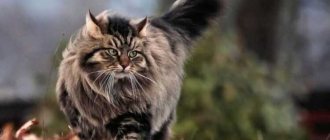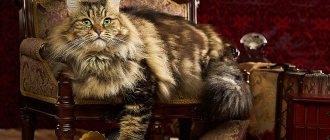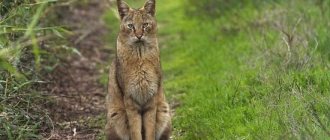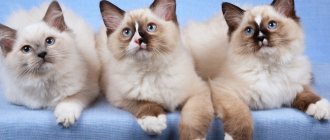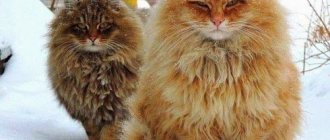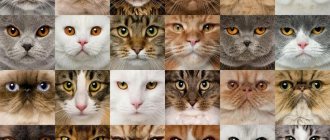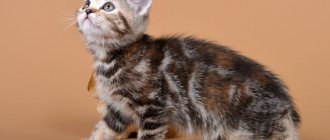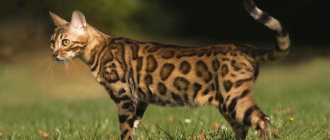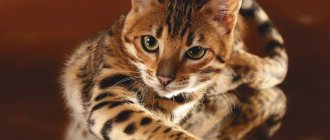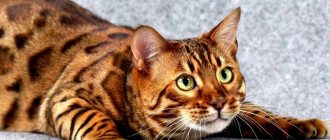Review author: “ZooVita”
Among the 36 breeds recognized by the International Federation of Cat Fanciers, the Russian Siberian cat occupies a worthy place.
Noble appearance, generous character, courage, friendliness - these are the qualities of the breed that attract cat lovers.
Story
The origin of the Siberian differs from most known breeds. Many of the currently existing cat species were bred after lengthy breeding work. Siberian, according to experts, is the result of natural selection. The cat was brought to the territory of Siberia by pioneers in the 17th-18th centuries.
No one was specifically involved in selection, and felinologists (specialists who study cats) believe that the formation of the breed was significantly influenced by the crossing of local and Persian cats.
Peculiarities
In addition to the beauty of these pets, it is necessary to note their melodic voice. They are truly loyal to their owner or owner and enjoy being together or just spending time together.
However, not only the Siberian’s affection and devotion to his person is a striking feature, this cat retains its natural independence and will never be intrusive, which is important when the owner is in a hurry about his business. It's easy to ruin your relationship with your pet - you just need to show aggression or anger. Having high intelligence allows Siberians to understand human speech and sense the mood around them.
Description rules
At the end of the 20th century, the current standard was approved, which distinguishes one breed from another. Existing canons of breed interpretation include taking into account the following factors:
- the weight of an elite representative of the species;
- height at withers;
- head shape;
- eye color and shape;
- tail;
- wool;
- general appearance of the physique.
Compliance
According to the standard descriptions of the Siberian cat, its data should be as follows:
- The body weight of an adult animal should reach ten kg.
- Height at the withers is forty centimeters for a male, ten centimeters less for a cat.
- The head is large. It allows the presence of tufts on the ears, which gives the Siberian a resemblance to its wild relative – the lynx.
- The eyes are oval, slightly slanted, and the color is either greenish or yellow.
- Fluffy and moderately long tail.
- A purebred cat must have two undercoats and an outer coat that is impermeable to water. In summer, Siberians look like short-haired breeds; only the tail remains fluffy. With the onset of cold weather, a cute collar appears, and the hind legs are decorated with fluffy “pants.” Well, the tail fluffs up even more.
Métis
The Siberian cat breed has no subspecies or varieties. But often there are mixed breeds or their descendants, cats that are one-quarter or three-quarters Siberian and have specific hunting traits. The most common Siberian mestizos, which have grown into a separate breed, are the Neva Masquerade cats. If for purebred Siberian cats this is one of the colors, then for Neva cats it is the breed standard, which breeders achieved by crossing mainly with Siamese breeds.
There are also mixed breeds from Siberians with Scottish Folds or Persian cats. The offspring often turn out beautiful, but such animals are not purebred. Such individuals often inherit genetic diseases and other disadvantages of both breeds from their parents.
Diseases
By nature, cats of the Siberian breed have excellent health. Experts believe that only a person with an incorrectly formulated diet and poor care can disrupt the animal’s good health. This is partly true, but at the same time cats can suffer from:
- urolithiasis;
- shortness of breath, lethargy and cough in old age.
In addition, prolonged loneliness can develop extreme excitability and activity in a cat.
Hair getting into the stomach of a pet also causes unpleasant consequences. Typically, a cat gets rid of hairballs using the gag reflex. In some cases, you should help the purr - give a tablespoon of sunflower oil. A teaspoon will be enough for a kitten.
In case of urolithiasis or senile ailments, you should contact a veterinarian.
Weight table by age
| Age | Weight |
| newborn | 60-130 gr. |
| 1 Week | 250 gr. |
| 2 weeks | 370 gr. |
| 3 weeks | 500 gr. |
| 4 weeks (approximately 1 month) | 540-700 gr. |
| 8 weeks (approximately 2 months) | 1-1.4 kg |
| 12 weeks (approximately 3 months) | 1.5-2.5 kg. |
| 24 weeks (approximately 6 months) | 3-5 kg. |
| 48 weeks (approximately 1 year) | 4.5-7 kg. |
Return to content
Color
The photo of Siberian cats shows how different colors breeders do not tempt potential buyers! Among the most popular we note the following:
- tricolor;
- ginger;
- brick;
- golden and silver;
- tortoiseshell;
- two-color;
- the coat has a blue tint, and the nose and paws are gray.
There are several other colors, for example, the gray Siberian cat and the Neva masquerade, but the federation of cat lovers has not yet approved them as a standard.
Please note ⭐⭐⭐
Oriental cat: characteristics of the breed, health, care and maintenance, rules for raising a kitten, price (150 photos)
Neva Masquerade cat: photo, description of breed and character, size, weight and color, pros and cons of the St. Petersburg cat
American shorthair cat: description of the breed, its character and care, nutrition (100 photos)
The color of a kitten's coat is determined by the influence of parental melanin. In nature, there are two types of this substance - black and red. The interaction of colors is the basis for the formation of all existing colors. The exception is the white color of animals.
How to determine what breed a kitten is?
To determine the breed of your new family member, there are several steps to remember. They are also an algorithm, so to speak, for identifying a kitten. Professionals use dozens of signs that can be used to determine the breed of a kitten or an adult cat. For non-professional breeders, there are several signs to look out for.
Citi Kitty cat toilet training system
Price: 720 rub. 1080 rub. 33% discount for you!
Trains in 3 weeks. Fast delivery throughout Russia. And also more than 3,000 other pet products at competitive prices! Take a look!
Conditions of detention
Maintaining a furry creature will not require much effort or time. Siberian purrs quickly get used to the tray and are neat and clean. Since cats have rather hard hair, it does not form tangles and does not need frequent brushing. It is enough to brush your fluffy beauty once a week. True, during the spring and autumn molting period the procedure will have to be carried out more often.
The Siberian cat does not like water and should be washed only after a walk in nature. During the water procedure, it is necessary to tightly close the ears with cotton wool, and the water temperature should be in the range of 38-39 degrees.
Considering the strength of Siberians, it is better to wash a cat together. After the “bath”, you need to thoroughly wipe your pet and let it dry in a warm room where there are no drafts.
Important! Regular cleaning of the ears is necessary, and the corners of the eyes should be wiped with a damp cotton swab.
Health of Siberian pets
Siberian cats are long-lived. Their average life expectancy is 17 years, although this figure often reaches 20 years or more.
Hereditary pathologies
Despite the good health of these animals, the risk of developing genetic diseases cannot be completely excluded. Siberians have at least one dangerous hereditary problem - the likelihood of hypertrophic cardiomyopathy.
Hypertrophic cardiomyopathy (HCM) is the most common form of heart disease in cats. It causes thickening (hypertrophy) of the heart muscle. An echocardiogram can confirm whether a cat has this condition.
Hypertrophic cardiomyopathy consists of thickening of the walls of the heart ventricles, due to which the organ cannot function properly
Avoid breeders who claim that their lines are free of HCM. No one can guarantee that their cats will never have such a pathology.
Siberians that are intended to breed should be tested for HCM. If the diagnosis is confirmed, animals should be excluded from breeding programs. Do not buy a kitten whose parents have not been tested for this disease.
Hip dysplasia is another inherited disease that is common in large cats. This pathology can be combined with a dislocation of the knee joint. The disease can occur in different forms:
- mild - subluxation with slight displacement of the joint;
- severe - degeneration of the joint.
In general, with dysplasia, there is a loss of correspondence between the articular surfaces, which leads to dislocation or arthrosis. At the same time, cats experience pain, begin to limp, try to move less, and when walking they begin to “wiggle their butts.” Gradually, the femoral muscle group atrophies.
Hip dysplasia is a severe hereditary pathology in cats.
This disease is easier to prevent than to cure. Therefore, large cats should receive a special vitamin complex; it is better to consult a veterinarian about its composition.
Other diseases
More than 40% of domestic cats are overweight. Unfortunately, we have long had a “national” stereotype of beauty in relation to pets - the fatter the cat, the better. Meanwhile, excess weight can cause or accelerate the development of many diseases in cats:
- type 2 diabetes and other endocrine disorders;
- urolithiasis;
- liver diseases;
- diseases of the skin and pancreas (pancreatitis);
- joint diseases.
Siberians who lack physical activity are prone to rapid weight gain.
Siberians, like other long- and semi-long-haired cats, may experience intestinal blockage, the cause of which is hair that gets into the digestive tract. Therefore, help your cat care for its fur coat. Once every two months you can give your pet a special paste to cleanse the intestines of hair. But the best option is fresh grass. If a cat has the opportunity to “graze” while walking, then she will find the plants she needs on her own. And if your pet lives in an apartment, then you can grow grass on the windowsill.
Cat grass can be grown on a windowsill to cleanse the digestive tract of fur.
It should still be noted that in general, Siberian cats are quite strong and healthy animals.
Nutrition
Cats are not picky when it comes to food, but having an excellent appetite and knowing the weaknesses of their owners, they abuse this and beg from them for various delicacies.
Please note ⭐⭐⭐
- Burmese cat - photo of the sacred cat, pet care and keeping at home (110 photos)
British shorthair cat - features of cat care, its colors, selection of proper nutrition (110 photos)
Ragdoll - 120 photos, description of appearance and color, her character, how she gets along with other pets
Recommended diet:
- raw lean beef (need to be doused with boiling water);
- poultry meat;
- boiled sea fish;
- dairy products (cottage cheese, cheese, fermented baked milk).
Kittens, nursing mothers and cats expecting offspring benefit from low-fat cream and goat's milk.
As supplements, you can give boiled egg yolk and a minimum amount of dry food of the highest quality.
Many cat lovers accustom their pets to rice, buckwheat and oatmeal porridge.
This is interesting
- The first mention of Siberian cats dates back to the 16th century. But then they were called Bukhara cats.
- Representatives of this breed are excellent hunters. Having a Siberian cat in the house, you can forget about the existence of any rodents.
- Cats are wonderful fathers and help their “wives” raise their children.
- They are distinguished by monogamous relationships. Cats enter into a “love” relationship with only one cat.
- Siberians are independent and independent creatures. These kinds of pets are suitable for people who do not have the opportunity to devote a lot of time to their pets. Without its owners, the cat will not be bored, but will find something to do to its liking.
- Tortoiseshell males, as a rule, do not give birth to offspring.
- Siberian cats get along well with small children and dogs.
- They recognize only one owner; the rest of the household, at best, are considered only their equals.
- They love boiled shrimp and for the sake of this delicacy they can resort to “blackmail”, refusing to eat other foods.
Character and habits
Siberian cats are calm, balanced, friendly, and delicate. But they are often stubborn and capricious. Strangers are treated with distrust, suspicion, and even some aggression. A stranger should not pet an animal, especially if it is not predisposed to affection.
“Siberians” treat their owner with boundless love and devotion, but without intrusiveness. The Siberian pet loves to spend time in the company of a person, but does not interfere with his work and rest, does not rub his legs, begging for affection, but sits calmly next to him, watching what is happening. The “Sibiryak” is smart and understanding, he perfectly senses when the owner is out of sorts, sad and upset, and tries to support and cheer up with meows and purrs.
Interesting! Representatives of the breed are excellent steeplejacks. They love to climb onto high furniture and watch from there what is happening below.
Siberian cats are loyal to children; if they wish, they can take part in children’s games and fun. But an elite pet does not allow itself to be treated like a living toy. If a child begins to play around and mock an animal, he will immediately be bitten or scratched.
Siberian cats live in harmony with other domestic animals, but only with those with which they are familiar from an early age. If you bring a new pet into your home, an adult “Siberian” will greet it with jealousy and aggression, even if the newcomer turns out to be a large dog. The Siberian cat is not afraid of aggressive animals and boldly fights them back.
From their wild forest ancestor, Siberian cats received unpretentiousness, high adaptive ability and hunting skills. There will be no rats or mice in the house where the “Siberian” lives.
If a Siberian pet lives in a private house, then you should let it out into the yard, and if in a city apartment, then regularly take it for a walk on a leash. Representatives of the breed are inquisitive, active, and their hunting instinct requires an outlet.
